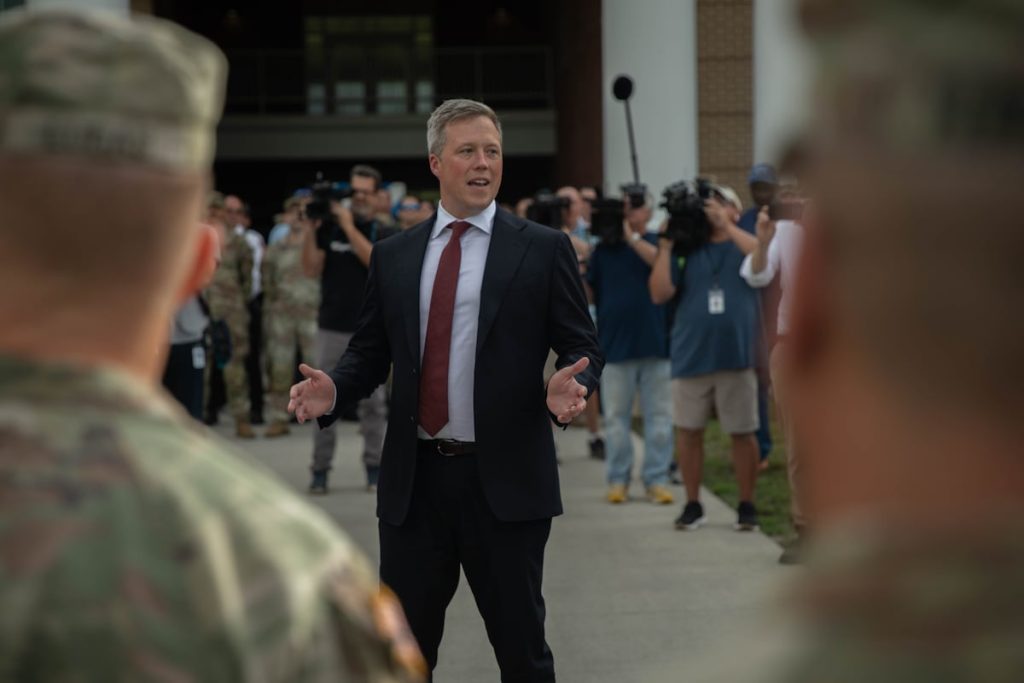In what may be a first for the staid Association of the U.S Army’s annual meeting in Washington, the Army secretary kicked off the conference with an F-bomb.
Dan Driscoll, who has served as the Army’s civilian leader since February, announced major coming changes to Army purchasing, parts repairs and technological adoption in a heated address that accused construction contractors of corruption and stressed that the lives of soldiers were on the line.
“We cannot f-ing wait to innovate until Americans are dying on the battlefield,” Driscoll said. “We must act now to enable our soldiers. Our window to change is right now, and we have a plan to do it. We will set the pace with innovation and we will win with silicon and software, and not with our soldiers’ blood and bodies.”
Driscoll walked out on the stage following an AI-generated video montage of soldiers and Army equipment — a display he said illustrated the technological chasm between legacy technologies and new capabilities that the Army had yet to cross.
“What we face right now, here in 2025, is an inflection point,” he said. “For our Army to meet this moment, every single person, especially those at this conference, must be able to answer yes to one very simple question: Am I focusing my energy and effort so that soldiers are ready to fight and win our nation’s wars? Because every minute we don’t, we place soldiers’ lives at risk. Our actions today decide the very fate of our future Army.”
Among coming changes, he said, is a new system that will combine Army equipment-purchasing entities under a single organization reporting directly to Army leadership and dramatically reduce the 12- to 18-month contracting cycle.
“We are going to completely disrupt the system that has held back the Army for decades and lined the prime [contractors’] pockets for so long,” he said. “We will break down barriers until we measure acquisitions, not in years and billions, but in months and thousands.”
Driscoll castigated the Army for its reliance on outdated equipment, pointing to a photograph showing a soldier born in 2004 working on a computer system fielded in 1995, a decade before his birth.
“Meanwhile, Ukraine is updating its drone software every couple of weeks,” he said. “It is absolutely unconscionable that we would send soldiers to war with 30-year-old, obsolete systems. This is the inflection point where we turn it all around.”
“Unequivocal failures” like the Boeing–Sikorsky RAH-66 Comanche helicopter (canceled in 2004), XM2001 Crusader self-propelled howitzer (canceled in 2002) and M10 Booker Light Tank (canceled earlier this year) have contributed to losing the public’s trust and cost billions, he said, while leaving troops without the contemporary gear they need.
“You have been let down,” Driscoll said, in a direct address to the soldiers in attendance. “You have been fighting, deploying, training and preparing for years, and you’ve always had each other’s backs, but unfortunately, your civilian leadership hasn’t always done the same for you.”
Driscoll also brought aircraft parts on to the stage: a fin for a UH-60 Black Hawk’s external fuel tank and a tiny Black Hawk screen control knob. The parts, he said, could be 3D-printed at higher quality for about $3,000 and $60 respectively, but cost $14,000 and $47,000 for full assembly replacements from the manufacturer. That amounted to $180,000 in unnecessary Army spending every month and months of delays, Driscoll said, and underscored the Army’s need to secure the right to repair its own equipment without losing manufacturer support. Driscoll ordered earlier this year that current and future Army contracts include this right.
“This is why your tank, howitzer or vehicle sits in the motor pool and you can’t use it to train for combat. And if the right to repair is bad in garrison, it will be so much worse in contested Indo-Pacific logistics,” he said. With accelerated efforts to field advanced manufacturing capabilities including 3D printing across the Army, he said, “soldiers will be able to download the schematic, manufacture it and install it all in the field.”
He cited other “disruptive” initiatives on display at the show, including a “Shark Tank”-like program to apply venture capital to Army tech initiatives, campus-style dining facilities and adoption of 3D-printed concrete structures to cut construction costs.
Driscoll served in the Army from 2007 to 2011 as an officer, earning a Ranger tab and deploying to Iraq. Having moved from there to the law field and then investment banking and venture capital, including a stint as the chief operating officer of Flex Capital, Driscoll said he could “say unequivocally that the Silicon Valley approach is absolutely ideal for the Army.”
“We will train our system to move fast,” he said. “And soon, Ukraine won’t be the only Silicon Valley of warfare.”
Read the full article here


